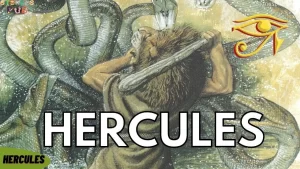Medusa: The Feared Monster of Greek Mythology

Medusa is a figure from Greek mythology who is best known for her serpentine hair and a gaze that could turn anyone who looked at her into stone.
Medusa’s family background
Medusa, in Greek mythology, is generally depicted as a monster and not as a wife or mother. In most versions of the myth, she is not married and does not have children.
However, in some accounts, Medusa is said to have been one of the three Gorgon sisters, along with Stheno and Euryale. The Gorgons were said to be powerful monsters with snakes for hair, sharp teeth, and the ability to turn anyone who looked at them into stone.
You would also like to Read List of Greek Goddesses
As for Medusa’s background, she was once a beautiful woman who was transformed into a monster as a punishment from the gods. According to one version of the story, Poseidon sexually assaulted her in Athena’s temple, and as a result, Athena punished her by turning her hair into snakes and giving her the ability to turn anyone who looked at her into stone.
It’s important to note that the details of Medusa’s background and relationships are largely the product of ancient Greek storytelling and cultural beliefs.
How beautiful women turned into monsters
Medusa was once a beautiful woman with golden hair, but she was eventually transformed into a monster as a punishment from the gods. According to one version of the story, Poseidon sexually assaulted her in Athena’s temple, and as a result, Athena punished her by turning her hair into snakes and giving her the ability to turn anyone who looked at her into stone.
You would also like to Read Tales of Ancient Greek Heroes
Medusa lived in a dark and desolate cave and was shunned by all who knew her. She was eventually killed by the demigod Perseus, who was tasked with bringing her head back to King Polydectes as proof of his bravery.
Why was Medusa cursed?
The “Medusa curse” is a reference to the myth of Medusa in Greek mythology, where Medusa was said to have the power to turn anyone who looked at her into stone. The curse referred to the danger posed by her gaze and the danger of being transformed into stone.
In the story, Medusa was once a beautiful woman who was punished by the gods for her vanity and pride by being transformed into a monster with snakes for hair and the power to turn anyone who looked at her into stone. The demigod Perseus eventually killed her while she was residing in a pitch-black, desolate cave.
You would also like to Read List of Greek God
The Medusa curse became a symbol of the dangers posed by those who were considered monstrous or dangerous, and the story was used to warn against the dangers of vanity and pride. It is also seen as a cautionary tale about the dangers of angering the gods, as Medusa’s punishment was the result of angering Athena.
Overall, the “Medusa curse” is a reference to the power of the gaze and the dangers posed by people who were seen as monsters or threats to society in ancient Greek culture.
Medusa Death
Medusa was killed by the demigod Perseus in Greek mythology. According to the story, Perseus was tasked with killing Medusa as part of a quest to prove his bravery. King Polydectes had asked Perseus to bring him the head of Medusa, who was a powerful monster with snakes for hair and the ability to turn anyone who looked at her into stone.
You would also like to Read Zagreus Story
Perseus, with the help of Athena and Hermes, was able to successfully slay Medusa and bring her head back to King Polydectes as proof of his bravery. The story of how Perseus killed Medusa is often seen as a warning about how dangerous it is to anger the gods. It is also seen as a symbol of how dangerous it was to be a monster or a threat to society in ancient Greek culture.
It is also worth noting that in some versions of the myth, the killing of Medusa is seen as a symbol of the triumph of good over evil, as Perseus is a hero who overcomes a powerful and dangerous monster. The story of Perseus and Medusa has been around for a long time in Western culture, and it is still an important part of the ancient Greeks’ mythology.
Medusa’s power and limitations
Some of the key powers and abilities associated with Medusa include:
Petrification: Medusa had the power to turn anyone who looked at her directly in the eyes into stone. This power made her a formidable adversary, as anyone who confronted her was at risk of being turned into stone.
You would also like to Read Mighty Hecatoncheires Story
Snakes for hair: Medusa’s hair was said to be made of snakes, which added to her fearsome appearance and made her even more dangerous. The snakes were said to be able to strike out and bite anyone who came too close.
Immortality: In some versions of the myth, Medusa was said to be immortal and could not be killed by normal means.
Despite her powerful abilities, Medusa also had some limitations. For example, she was often depicted as living in a dark and desolate cave, which limited her mobility and access to the outside world. Additionally, just like Perseus, she was susceptible to death at the hands of a hero with the aid of the gods.
Why did Athena punish Medusa instead of Poseidon?
Medusa was punished by Athena because she had been violated by Poseidon in Athena’s temple. According to the story, Medusa was a priestess of Athena who was renowned for her beauty. Poseidon, the god of the sea, saw her and was overcome by desire. He pursued Medusa and, in his lust, violated her in Athena’s temple.
You would also like to Read Aeneas: The Hero of Troy
Athena was outraged by this sacrilegious act and punished Medusa by transforming her into a monster with snakes for hair. This change was meant to warn people not to mess up the temple of the gods and show how dangerous people who were seen as monsters or threats to society were in ancient Greek culture.
It is worth noting that in some versions of the myth, Poseidon was not punished for his actions because he was considered to be a powerful god and above reproach. But in the most popular version of the story, it was Medusa, not Poseidon, who was punished for breaking into Athena’s temple.
You would also like to Read Creatures of Ancient Greece
Interesting Facts about Medusa
- Medusa was once a beautiful woman: According to Greek mythology, Medusa was once a beautiful priestess of Athena who was punished for having sexual relations with Poseidon in Athena’s temple.
- Medusa was a Gorgon: The Gorgons were a group of three sisters in Greek mythology, of which Medusa was the most famous. The other two were Stheno and Euryale.
- Medusa’s hair was made of snakes: After her transformation, Medusa’s hair turned into snakes, and anyone who looked into her eyes was turned to stone.
- Medusa was defeated by Perseus: The hero Perseus was tasked with killing Medusa as one of his Twelve Labors. He was able to defeat her by using a reflective shield to avoid looking directly into her eyes, and by cutting off her head while she was asleep.
- Medusa’s head was used as a weapon: After defeating Medusa, Perseus gave her head to Athena, who placed it on her shield as a symbol of her power and protection.
- Medusa was a symbol of female empowerment: Despite being portrayed as a monster in some stories, Medusa was also seen as a symbol of female power and a protector of women.
- Medusa was not immortal: Despite her fearsome reputation, Medusa was not immortal and could be killed just like any other mortal.
- Medusa’s story has been retold many times: Medusa’s story has been retold in many different forms over the centuries, including in works of art, literature, and film.
- Medusa’s story has inspired many interpretations: Medusa’s story has been interpreted in many different ways, including as a cautionary tale about the dangers of angering the gods, as a symbol of female empowerment, and as a representation of the transformative power of myth.
A lesson from the Medusa story
Some of the key lessons that can be learned from the story of Medusa include:
The dangers of angering the gods: The story of Medusa serves as a cautionary tale about the dangers of angering the gods and the consequences of violating their temples or laws.
The dangers of vanity and pride: Medusa was known for her beauty, and her violation of Athena’s temple is often seen as a symbol of the dangers of vanity and pride.
The dangers posed by those who are considered monsters or threats to society Medusa’s transformation into a monster is often seen as a symbol of the dangers posed by those who are considered to be monsters or threats to society.
The importance of bravery: The story of Perseus and Medusa highlights the importance of bravery and the dangers of fear. Perseus was able to get over his fear and kill Medusa, which showed how brave he was and made people respect him.
The power of transformation: The transformation of Medusa from a beautiful priestess into a monster is often seen as a symbol of the power of transformation and the dangers of unchecked anger and rage.
Hey kids, how much did you like Medusa: The Feared Monster of Greek Mythology? Please share your view in the comment box. Also, please share this story with your friends on social media so they can also enjoy it, and for more such stories, please bookmark storiespub.com.
Check out other stories that we have:





